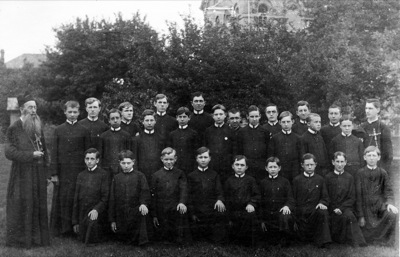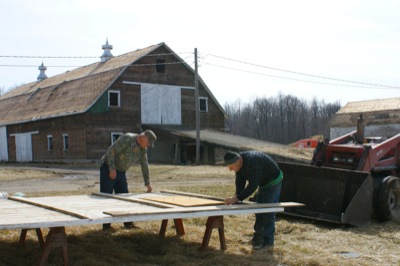Tuesday, April 8th, 2014
Catholic history rooted in Burkettsville
Buildings associated with religious complex to be razed
By Shelley Grieshop

Submitted Photo
Known locally as the Burkettsville novitiate, the once sprawling, three-story main building opened in the spring of 1884 as the Mother of Divine Grace. It served as a seminary, a retirement home, a retreat for contemplating a vocation with the Precious Blood Society, and a home for troubled youth. It was destroyed by fire in 1971.
BURKETTSVILLE - A small orchard and aging buildings are all that remain of a once towering religious complex established locally 130 years ago.
The main three-story structure was destroyed by arson in a scandalous incident in 1971. Other buildings - including a bank barn damaged last year by high winds - will soon be razed at the historic site on state Route 118, a mile north of the village of Burkettsville.
The property is owned by the Precious Blood Society and holds good memories for retired priest, the Rev. Ken Schroeder, who spent his "year of silence" there as a seminarian contemplating his vocation.
"There were 19 of us novices ... We had classes in the morning and worked all afternoon. I liked that; anything to get out of school," he said with a laugh.
Schroeder, the former head pastor of the Marion cluster of Catholic churches, recalled chores such as pasteurizing milk during his stay from 1958 to 1959. But one of his most vivid memories is the "great food" cooked by one of the sisters.
"She took good care of us. She would make apple pies and cut them into quarters, really big pieces. I liked that," he said.
Mass was held twice each day in the chapel; there was "a lot of praying in those days," Schroeder said. The young men were given ample recreation time and enjoyed playing softball at the on-site ball diamond not far from a pond, grotto and stations of the cross.
Novices were allowed to write letters to their parents throughout the year but could have no visitors.
"It was a closed year for us," Schroeder explained."Nobody was allowed to talk to us except our work boss. It was strict, but a very special year."
Brother Theophane Woodall was Schroeder's classmate. He remembers selling apples from the orchard with one of the priests at the novitiate. He was 18 and nearly 100 miles away from his family in Miamisburg when he arrived to contemplate his future.
"For me it was a very happy time," he said, adding he kept busy doing tasks such as laundry and gardening.
Through the years the property served as a seminary and school, a retirement home and a halfway house for troubled black youth.
The "Mother of Divine Grace," as it initially was called, opened April 15, 1884, and later was dubbed "Saint Mary's." The goal of the facility was "to provide a better job of screening prospective members," according to "The American/Cincinnati Province of the Society of the Precious Blood: A Chronological Account."
"The novice master ... would divide candidates into three categories: bad eggs, the talented, and the remainder. The bad eggs would be tossed out and the talented would be sent to the seminary. The remainder would become brothers, trained in housework, cooks for small rectories and mission houses," the book states.
In 1894, a new and bigger building was erected. In September 1919, the facility was renamed Saint Mary's Preparatory Seminary. One year later, a one-story building was constructed south of the main building and included a basement with a basketball court, two bowling alleys and a pool room.
In 1951, the Society built an addition to the main building at a cost of $400,000. That year the complex became the official novitiate for the American Province.
The sole purpose of the campus changed in 1969. Precious Blood officials during a Business Chapter meeting in Carthagena voted to end the annual $25,000 subsidies for operations.
The Society in 1970 agreed to rent the property for "Project Liberation" - a program that brought in 50 young black men from poor neighborhoods in Lima and Toledo for training and remedial academic work.
Local priests and brothers said the program was not well received by area residents. History books cited "deep resentment and fear in the county" and noted many people felt Project Liberation was a "leftist trend" in church activities.
A suspicious fire broke out in the main building about midnight Jan. 1, 1971, while the students were away on Christmas break. The structure was destroyed and the state fire marshal's office declared the cause to be arson.
The Society was unable to sell the property or find a suitable purpose for it after the fire. Several buildings were torn down in 1978 and the pond was filled in. More than 450 acres were farmed by Precious Blood brothers until 2005; today the land is leased and the remaining buildings are used for storage.
Schroeder, who now resides a few miles away at St. Charles Center, periodically drives by the desolate farm. The whistling wind - the only sound for miles - reminds him of the traditional chorus recited hourly by the religious candidates.
"At the top of every hour we hollered "Presence of God," he said. "It didn't matter what we were doing, even butchering hogs, we shouted the words to remind us that He was always with us."

Submitted Photo
Young seminarians from the Burkettsville class of 1908-1909 pose with their instructors at a site along state Route 118, a mile north of the village. Pictured are the Rev. Joseph Heitz, at left, and the Rev. Hubert Seiferle, right.

Submitted Photo
Roger Flaute, left, and Brother Nick Renner last week salvage wood from a structure to be razed on the site of the former Burkettsville novitiate. The bank barn in the background was damaged last year by high winds and is one of the structures to be taken down.
